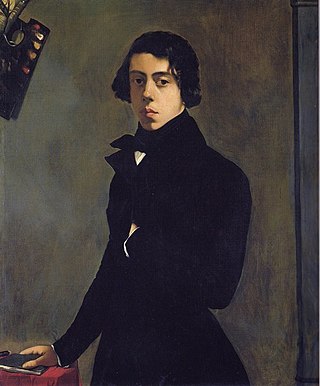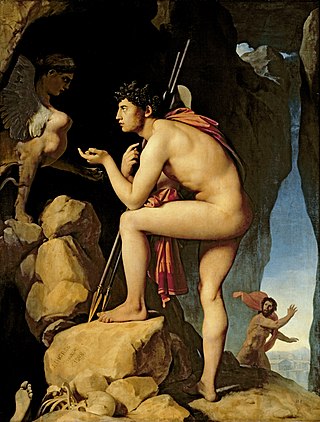
Jean-Auguste-Dominique Ingres was a French Neoclassical painter. Ingres was profoundly influenced by past artistic traditions and aspired to become the guardian of academic orthodoxy against the ascendant Romantic style. Although he considered himself a painter of history in the tradition of Nicolas Poussin and Jacques-Louis David, it is his portraits, both painted and drawn, that are recognized as his greatest legacy. His expressive distortions of form and space made him an important precursor of modern art, influencing Picasso, Matisse and other modernists.

Théodore Chassériau was a Dominican-born French Romantic painter noted for his portraits, historical and religious paintings, allegorical murals, and Orientalist images inspired by his travels to Algeria. Early in his career he painted in a Neoclassical style close to that of his teacher Jean-Auguste-Dominique Ingres, but in his later works he was strongly influenced by the Romantic style of Eugène Delacroix. He was a prolific draftsman, and made a suite of prints to illustrate Shakespeare's Othello. The portrait he painted at the age of 15 of Prosper Marilhat makes Chassériau the youngest painter exhibited at the Louvre museum.

Grande Odalisque, also known as Une Odalisque or La Grande Odalisque, is an oil painting of 1814 by Jean-Auguste-Dominique Ingres depicting an odalisque, or concubine. Ingres' contemporaries considered the work to signify Ingres' break from Neoclassicism, indicating a shift toward exotic Romanticism.

Madame Moitessier is a portrait of Marie-Clotilde-Inès Moitessier begun in 1844 and completed in 1856 by Jean-Auguste-Dominique Ingres. The portrait, which depicts Madame Moitessier seated, is now in the collection of the National Gallery in London, which acquired it in 1936.

Portrait of Monsieur Bertin is an 1832 oil on canvas painting by Jean-Auguste-Dominique Ingres. It depicts Louis-François Bertin (1766–1841), the French writer, art collector and director of the pro-royalist Journal des débats. Ingres completed the portrait during his first period of success; having achieved acclaim as a history painter, he accepted portrait commissions with reluctance, regarding them as a distraction from more important work. Bertin was a friend and a politically active member of the French upper-middle class. Ingres presents him as a personification of the commercially minded leaders of the liberal reign of Louis Philippe I. He is physically imposing and self-assured, but his real-life personality shines through – warm, wry and engaging to those who had earned his trust.

The Turkish Bath is an oil painting by Jean-Auguste-Dominique Ingres, initially completed between 1852 and 1859, but modified in 1862. The painting depicts a group of nude women at a pool in a harem. It has an erotic style that evokes both the Near East and earlier western styles associated with mythological subject matter. The painting expands on a number of motifs that Ingres had explored in earlier paintings, in particular The Valpinçon Bather (1808) and La Grande odalisque (1814).

Odalisque with Slave is an 1839 painting by Jean-Auguste-Dominique Ingres commissioned by Charles Marcotte. Executed in oil on canvas, it depicts a nude odalisque, a musician, and a eunuch in a harem interior. The painting is in the Fogg Art Museum in Cambridge, Massachusetts. It is a classic piece of Orientalism in French painting.

Roger Freeing Angelica or Ruggiero Freeing Angelica is an 1819 painting by the French artist Jean-Auguste-Dominique Ingres, inspired by Orlando Furioso by Ariosto. An oil painting on canvas measuring 147 x 199 cm, it is owned by the Louvre. Ingres subsequently painted several variants of the composition.

Oedipus and the Sphinx is a painting by the French Neoclassical artist Jean-Auguste-Dominique Ingres. Originally a student work painted in 1808, it was enlarged and completed in 1827. The painting depicts Oedipus explaining the riddle of the Sphinx. An oil painting on canvas, it measures 189 x 144 cm, and is in the Louvre, which acquired it in 1878.

Portrait of Madame de Senonnes is an 1816 painting by Jean-Auguste-Dominique Ingres. It shows Madame de Senonnes, née Marie-Genevieve-Marguerite Marcoz, viscountess of Senonnes (1783–1828). Marcoz was 31 when the portrait was completed. Ingres had earlier portrayed her in a drawing of 1813.

Portrait of Madame Duvaucey is an 1807 oil on canvas painting by Jean-Auguste-Dominique Ingres. It shows Antonia Duvauçey of Nittis, the lover of Charles-Jean-Marie Alquier, then ambassador to the Holy See. Duvaucey is positioned in a flat pictorial space, gazing frontally at the viewer, dressed in lavish clothing and accessories. The portrait is the first female portrait painted during the artist's stay in Rome. Portrait of Madame Duvaucey is acclaimed for exhibiting her enigmatic charm, and as "not a portrait that gives pleasure..[but]...a portrait that gives rise to dreams".

The Portrait of Comtesse d'Haussonville is an 1845 oil-on-canvas painting by the French Neoclassical artist Jean-Auguste-Dominique Ingres.

Portrait of Madame Ingres is a late period oil on canvas painting by the French Neoclassical artist Jean-Auguste-Dominique Ingres, completed in 1859. Depicting his second wife Delphine Ramel, it is Ingres' final painted portrait, apart from two self-portraits. It was probably painted to accompany Ingres's self-portrait of the same year, now in the Fogg Art Museum, Boston.

Portrait of Charles Marcotte is an 1810 oil on canvas painting by the French Neoclassical artist Jean-Auguste-Dominique Ingres, completed during the artists first stay in Rome. Charles Marie Jean Baptiste Marcotte (1773-1864) was a long term friend, loyal supporter and adviser to Ingres, and commissioned a number of portraits of his family and friends, as well as works such as Odalisque with Slave (1839). He was 23 years in age when the portrait was painted, and serving as inspector general for Waters and Forests in Napoleonic Rome.

Self-Portrait at Seventy-Eight is an 1858 oil-on-canvas painting by the French Neoclassical artist Jean-Auguste-Dominique Ingres. It is one of the last of his many portraits, which he had always regarded as bothersome distractions from his true calling, history painting. The painting measures 24 3/8 x 20 1/8 inches and is in the Uffizi Gallery, Florence.

Portrait of Marie-Françoise Rivière is a c. 1805 oil-on-canvas painting by the French Neoclassical artist Jean-Auguste-Dominique Ingres.

Portrait of Philibert Rivière is a c. 1805 oil on canvas painting by the French Neoclassical artist Jean-Auguste-Dominique Ingres. It was commissioned by Philibert Rivière de L'Isle, an influential court official in the Napoleonic Empire, along with portraits of his wife, Philibert and their daughter, Caroline.

Portrait of Caroline Murat, Queen of Naples is an 1814 oil on canvas painting by the French Neoclassical artist Jean-Auguste-Dominique Ingres. Caroline Murat, née Bonaparte, was the sister of Napoleon, and married Joachim Murat, a Marshal of France and Admiral of France, and later King of Naples. Caroline commissioned the portrait as part of an effort to convey her standing and worth to reign as Queen of Naples during an unstable political climate.

Amédée-David, the Comte de Pastoret (1823-1826) is a portrait by French painter Jean-Auguste-Dominique Ingres. The oil on canvas painting depicts Count Amédée-David de Pastoret at 32 years old, wearing a medal of the Order of the Legion of Honor.




















